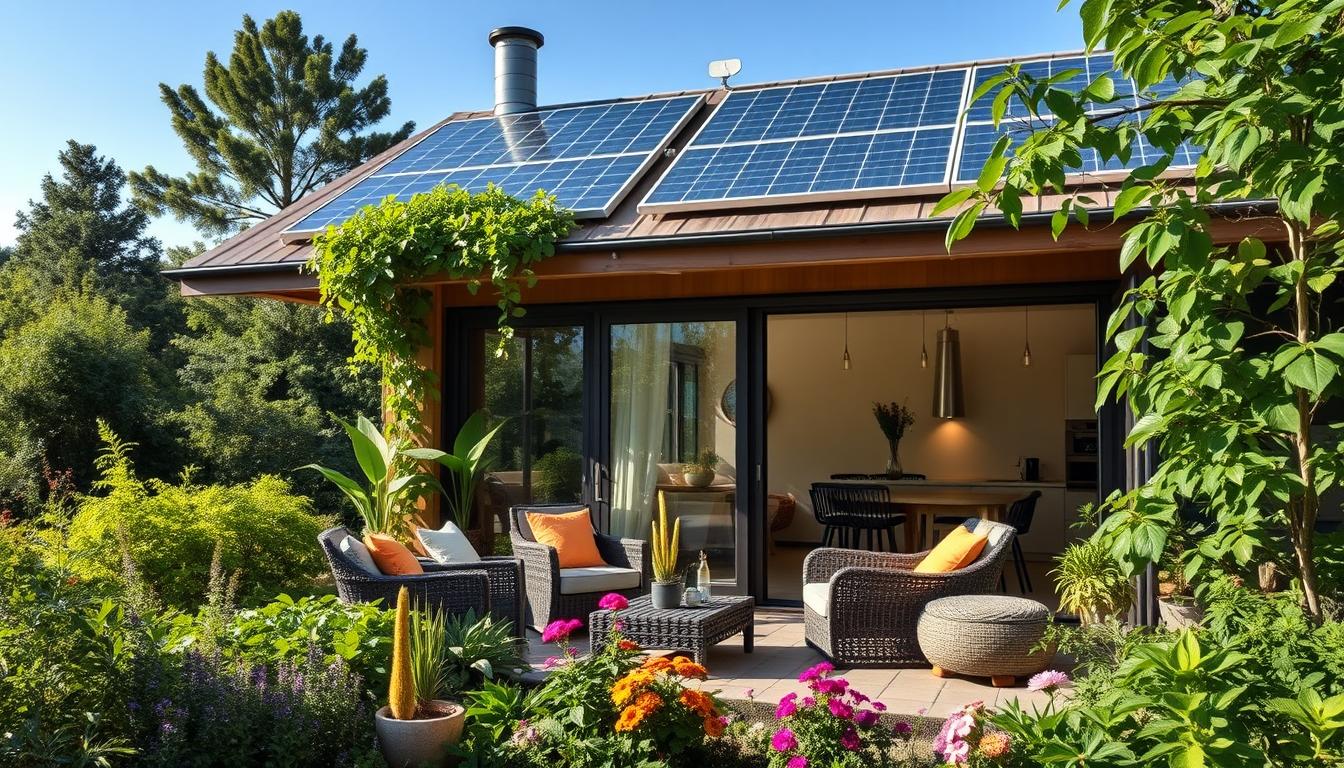Creating a home that’s good for the planet and looks great is now a top goal for many. By using green architecture and sustainable living, you can make your home better for the environment. This guide will show you how to make a home that’s both beautiful and eco-friendly.
This article will teach you about energy-saving windows and insulation. It will also cover eco-friendly materials. We’ll look at green architecture, the perks of living sustainably, and smart home tech for better energy use.
If you’re building a new home or upgrading your current one, this guide is for you. It will give you the tools and ideas to create a green home that shows your values. By combining beauty and sustainability, you’ll help the planet and enjoy a stylish, comfortable home.
Understanding the Fundamentals of Sustainable Home Design
Creating an eco-friendly home starts with knowing green building principles and sustainable architecture. It’s about making choices that are good for the planet. These choices help save energy and make homes more comfortable to live in.
Core Principles of Green Architecture
Green architecture focuses on using the sun’s power and materials wisely. It also includes using renewable energy. The goal is to use less energy by improving air flow, using natural light, and keeping temperatures comfortable.
Environmental Impact Assessment
Checking a home’s environmental impact is key in sustainable design. This step looks at how much carbon the home produces, how much water it uses, and its waste. By finding out where problems lie, architects can fix them to lessen the home’s harm to the environment.
Cost-Benefit Analysis of Going Green
Going green might cost more at first, but it’s worth it in the long run. Homeowners save on energy bills, their homes are more valuable, and they help the planet. Looking at the costs and benefits helps decide which green upgrades are best.
| Sustainable Home Design Principle | Key Benefits |
|---|---|
| Passive solar design | Reduced energy consumption, improved thermal comfort |
| Energy-efficient materials | Lower utility bills, increased home value |
| Renewable energy integration | Long-term energy independence, reduced carbon footprint |
Learning about sustainable home design helps people make smart choices. They can build homes that are not only beautiful but also good for the planet.
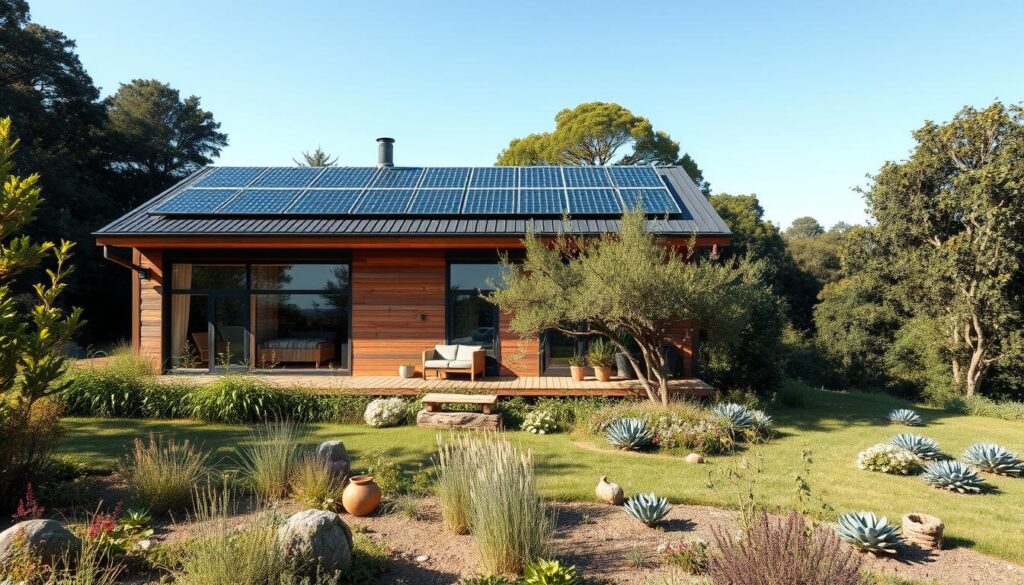
Energy-Efficient Windows and Insulation Solutions
Choosing the right windows and insulation is key to an eco-friendly home. Upgrading to energy-efficient windows and better insulation can cut down energy use and costs. It also makes your home more comfortable.
Double-pane windows with low-E glass are great for saving energy. They have an extra glass pane and a special coating. This coating reflects heat, keeping your home at a steady temperature. It’s a top choice for thermal insulation and energy conservation.
Good insulation is also vital for a green home. It keeps heat in during winter and out in summer. This reduces the work for your HVAC system and lowers your bills.
- Think about getting double-pane windows with low-E coatings for better energy conservation.
- Get strong thermal insulation for walls, ceilings, and attics to keep your home at the right temperature.
- Use energy-efficient windows and insulation together for a well-insulated, eco-friendly home.
“Upgrading to energy-efficient windows and insulation is one of the most cost-effective ways to reduce a home’s carbon footprint and save on long-term energy costs.”
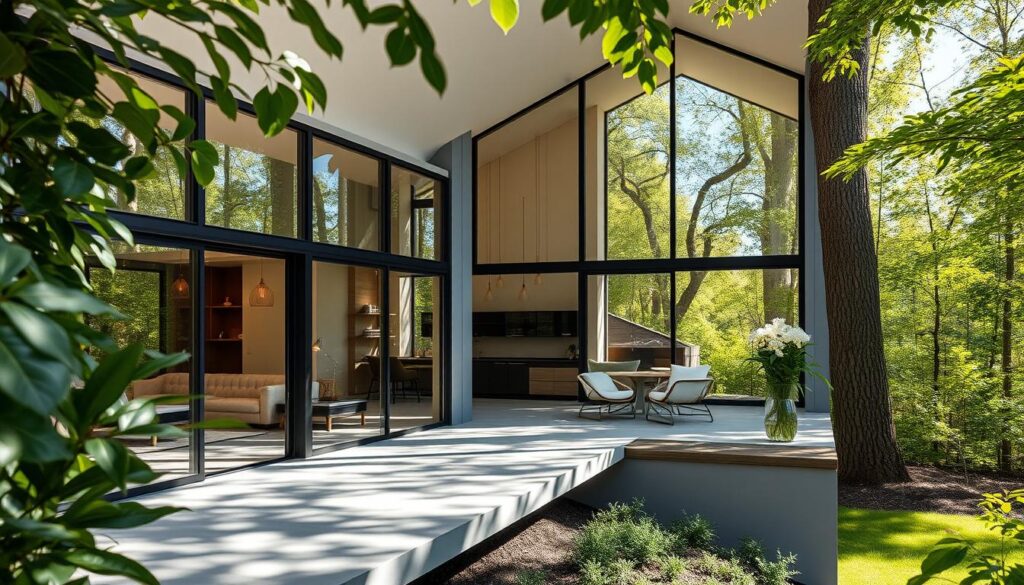
By choosing double-pane windows with low-E glass and good thermal insulation, you can make your home energy-efficient and eco-friendly. It will be both beautiful and sustainable.
Sustainable Building Materials for Modern Homes
Building an eco-friendly home doesn’t mean you have to give up style or comfort. There are many beautiful and innovative materials available. These materials can make your home look great and be good for the planet. You can choose from recycled and reclaimed materials, eco-friendly flooring, and paints with low-VOCs.
Recycled and Reclaimed Materials
Using recycled and reclaimed materials is key to sustainable building. Reclaimed wood adds a unique charm to your home and saves trees. Recycled steel, glass, and concrete can also be used to create stunning parts of your home.
Eco-Friendly Flooring Options
Bamboo and cork are great choices for flooring. Bamboo grows fast and can be harvested without harming the plant. Cork comes from the bark of trees and is natural and biodegradable.
Low-VOC Paints and Finishes
The paints and finishes in your home affect the air quality and the environment. Low-VOC paints have fewer harmful chemicals. This means better air quality in your home.
| Sustainable Material | Benefits |
|---|---|
| Reclaimed Wood | Unique character, reduced demand for new timber |
| Bamboo Flooring | Renewable resource, durable, visually appealing |
| Low-VOC Paints | Improved indoor air quality, reduced environmental impact |
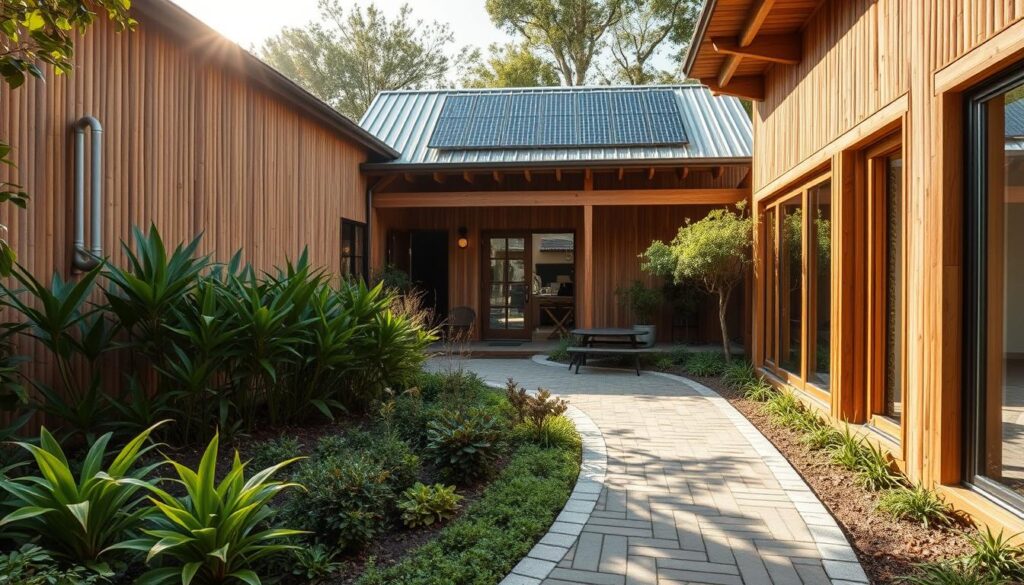
“Sustainable construction is not just about being eco-friendly; it’s about creating a better, healthier living environment for ourselves and future generations.”
Smart Home Technology for Energy Management
Smart home technology is changing the game for eco-friendly homes. It lets homeowners track and cut down their energy use with great accuracy. This leads to a more sustainable future.
The energy monitoring system is a key part of smart home tech. It shows how much energy your home uses in real time. Homeowners can then find out where energy is being wasted and lower their use.
Smart thermostats are another important tool. They learn your schedule and adjust the temperature to save energy. They can also work with other IoT devices to make your home more energy-efficient.
| Feature | Benefits |
|---|---|
| Energy Monitoring Systems | Provide real-time energy usage data, enabling targeted energy-saving strategies |
| Smart Thermostats | Automatically adjust heating and cooling to maintain comfort while reducing energy consumption |
| IoT Device Integration | Allows for a comprehensive home automation system that optimizes energy usage across various home systems |
Smart home tech helps homeowners make their homes more sustainable and energy-efficient. It lets them make smart choices, cut down on carbon emissions, and help the planet.
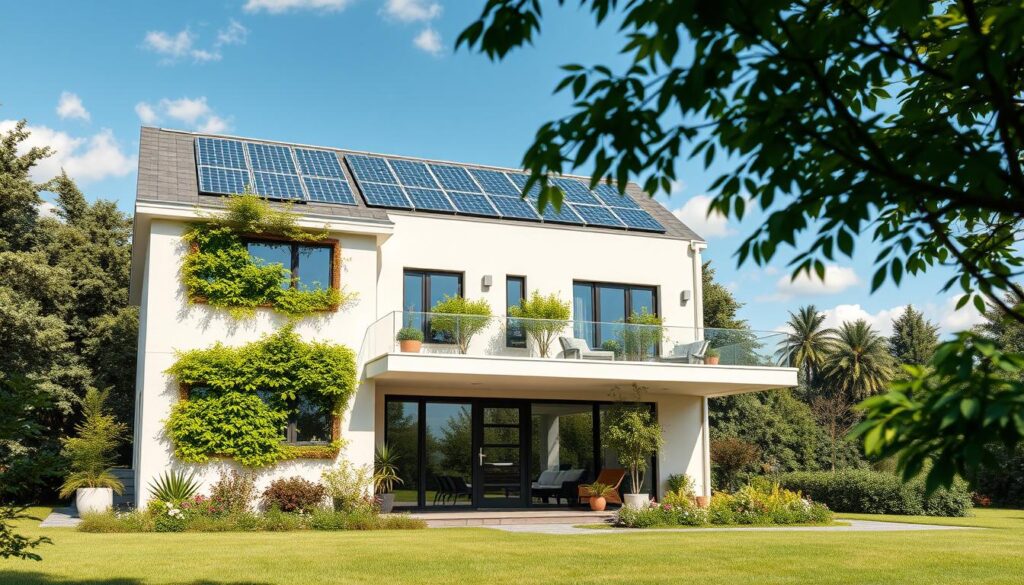
Water Conservation Systems and Fixtures
Homeowners are now more aware of their environmental impact. Water conservation is key to a sustainable home. This includes rainwater harvesting and greywater recycling. These methods help cut down water use and support water conservation.
Rainwater Harvesting Methods
Rainwater harvesting is a simple yet effective way to collect and store rainwater. It’s used for irrigation, toilet flushing, and laundry. By installing a rooftop collection system and a storage tank, you can use this valuable resource. This reduces your need for municipal water.
Greywater Recycling Systems
Greywater is wastewater from sinks, showers, and washing machines. It can be recycled for irrigation. Greywater recycling systems filter and divert this water. This way, you can use less freshwater and lower your water footprint.
Water-Efficient Appliances and Fixtures
- Low-flow showerheads and faucets: These use less water than traditional ones. They’re a simple way to cut down on water use.
- High-efficiency toilets: New toilets use less water than old ones. They can save thousands of gallons a year.
- ENERGY STAR-certified appliances: Appliances with the ENERGY STAR label are water-efficient. They help in saving water and lowering bills.
Using these water-saving techniques and fixtures can greatly reduce water use. It also lowers utility bills. Plus, it helps in making your community and environment more sustainable.
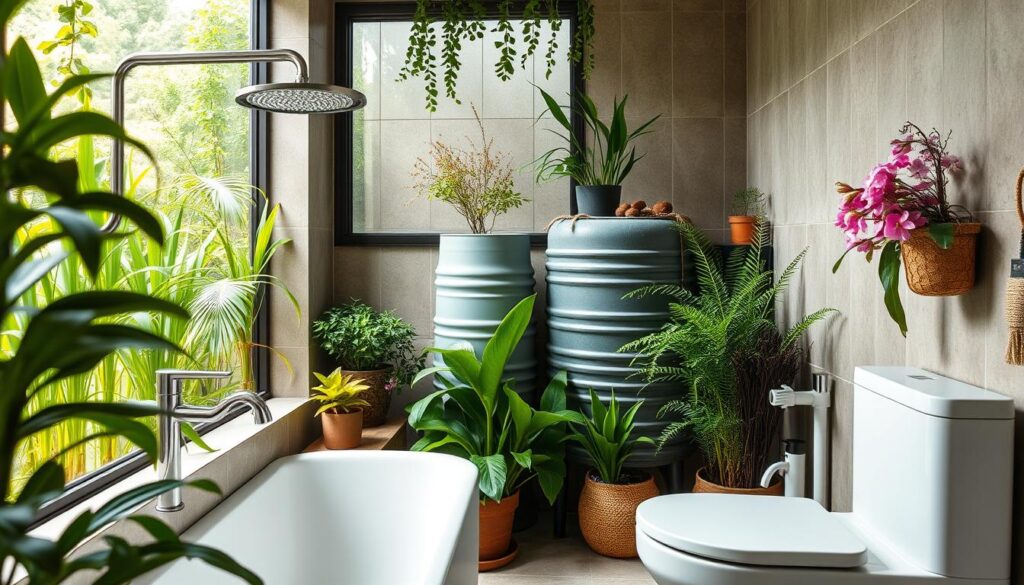
Natural Lighting Strategies and Design
Using natural light is key in sustainable home design. By using daylighting techniques, homes can use less artificial light. This makes homes brighter and more welcoming.
Skylights and light tubes are great for getting more natural light. They let sunlight into deep parts of the home. Skylights can also help warm the home, making it more energy-efficient.
- Skylights: Provide direct access to natural sunlight, flooding rooms with bright, natural illumination.
- Light tubes: Compact, cylindrical structures that channel sunlight from the roof into the interior of the home.
- Passive solar design: Strategically placing windows and other glazed surfaces to capture and harness the sun’s warmth, reducing the need for supplemental heating.
Windows, light colors, and reflective surfaces also help with daylighting. By planning these elements well, homes can use natural and artificial light better. This makes homes more sustainable and beautiful.
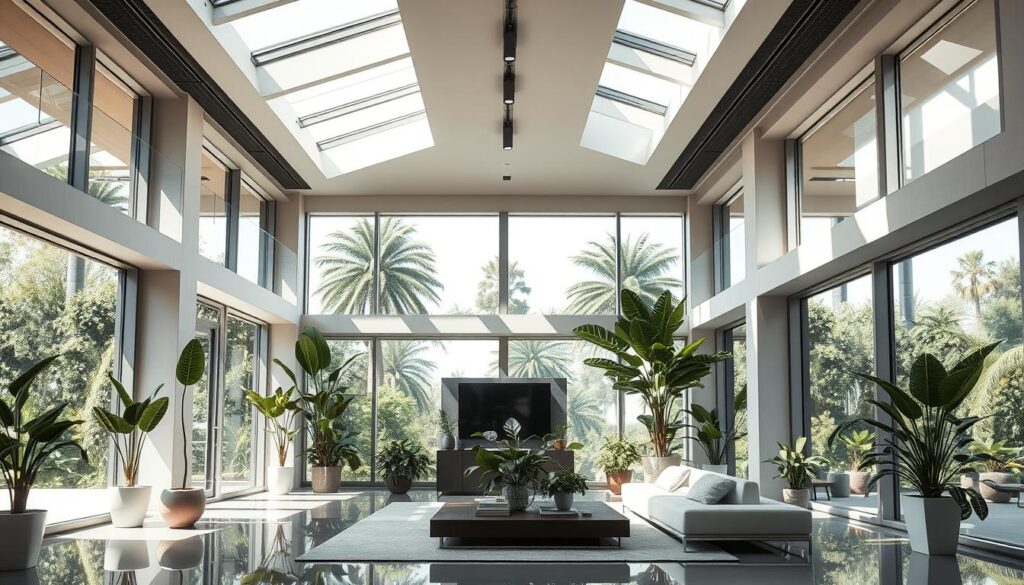
“Proper daylighting design can reduce a home’s energy consumption by up to 50%.”
| Daylighting Technique | Benefits | Considerations |
|---|---|---|
| Skylights |
|
|
| Light Tubes |
|
|
| Passive Solar Design |
|
|
How to Create a Green Home That’s Beautiful and Eco-Friendly
Making a home eco-friendly doesn’t mean it can’t be stylish. Sustainable interior design and eco-chic decor can blend well with green luxury homes. This results in spaces that are both beautiful and good for the planet.
Balanced Aesthetics and Sustainability
The secret to a green home that looks great is finding a balance. Choose sustainable building materials, energy-efficient systems, and biophilic design. These choices cut down on environmental harm while making your home look amazing.
Design Principles for Eco-Luxury
To make an eco-chic decor that feels luxurious, follow these tips:
- Use natural materials like reclaimed wood, stone, and bamboo for warmth and texture.
- Choose energy-saving lighting and smart tech to cut down on energy use without losing charm.
- Add indoor plants, like living walls and pots, to bring nature inside and support biophilic design.
- Go for eco-friendly fabrics and furniture to make your home look stunning and green.
By using these ideas, you can build a green luxury home. It will be not just beautiful but also show your dedication to living sustainably.
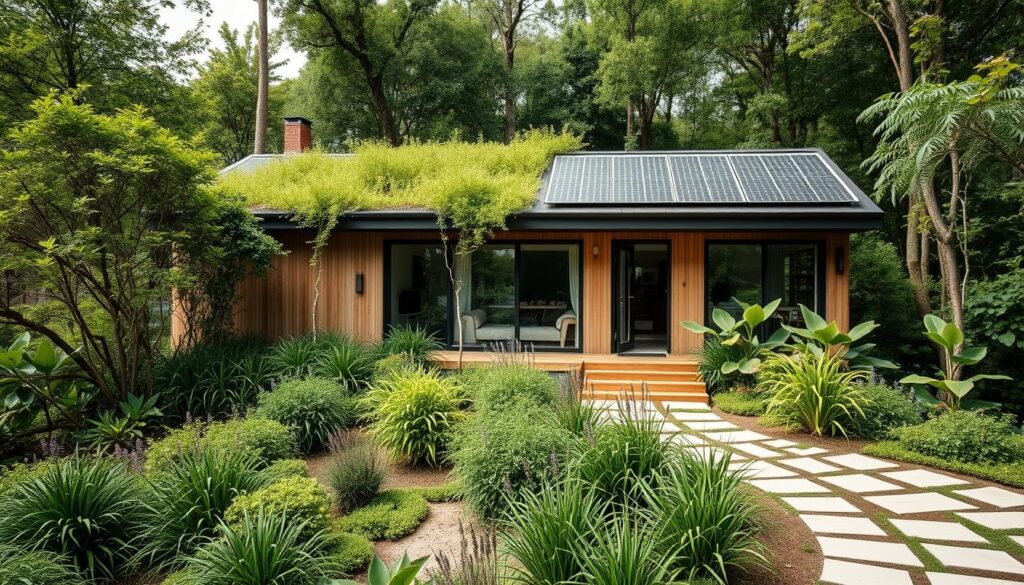
Indoor Air Quality Improvements
Building a green home is more than just using energy-efficient appliances and sustainable materials. It’s also about keeping the air inside clean and healthy. Using natural air filters, proper ventilation, and choosing materials free from toxins are key to a healthy home.
Enhance Ventilation for Better Air Circulation
Good ventilation is key to getting rid of stale air and bringing in fresh air. Think about adding air purification systems or updating your ventilation systems. This will help keep the air in your home clean and fresh.
Harness the Power of Natural Air Filters
Some plants can naturally clean the air in your home. They remove toxins and make the air healthier. Use toxin-free materials and place these plants in key spots to improve your home’s air quality.
- Snake plant
- Peace lily
- English ivy
- Aloe vera
Improving indoor air quality makes your home not just green but also healthier. By focusing on these areas, you can create a home that’s good for both the planet and your health.
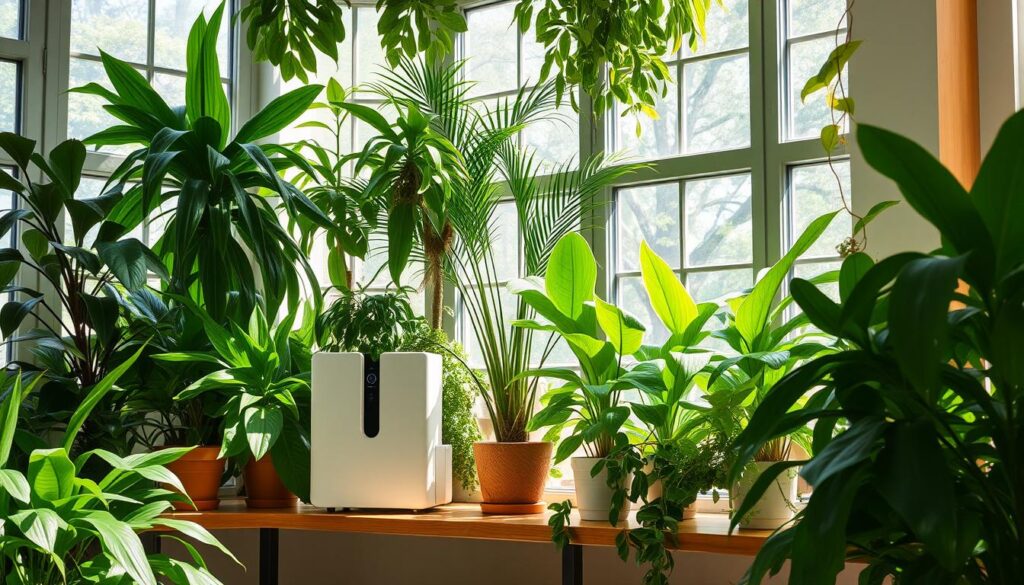
Renewable Energy Integration
Homeowners are now focusing on living in a more sustainable way. They’re turning to solar power and small-scale wind turbines. These options let them make their own clean energy.
Solar Panel Installation Guide
Installing solar panels is a top choice for those wanting to use the sun’s energy. First, you check how much sun your home gets. Then, you pick the right panels and inverters. Solar power systems can connect to the grid or work on their own.
- Evaluate your home’s solar exposure and potential energy needs
- Research solar panel efficiency, size, and compatibility with your property
- Hire a licensed solar installer to handle the design, permitting, and installation
- Explore financing options, such as solar leases or power purchase agreements
Wind Energy Options
For those with good wind, small wind turbines are a great choice. These systems can sit on roofs or stand alone. They make electricity to help or replace what you get from the grid. Though they need more setup than solar, they’re a solid clean energy option where wind is strong.
- Assess your property’s wind conditions and potential energy generation
- Select a wind turbine model that matches your energy needs and site constraints
- Ensure compliance with local zoning regulations and obtain necessary permits
- Work with a qualified installer to properly site and connect the wind system
Using solar and wind energy together helps homeowners use less traditional energy. This move towards off-grid living and renewable energy systems is good for our planet’s future.
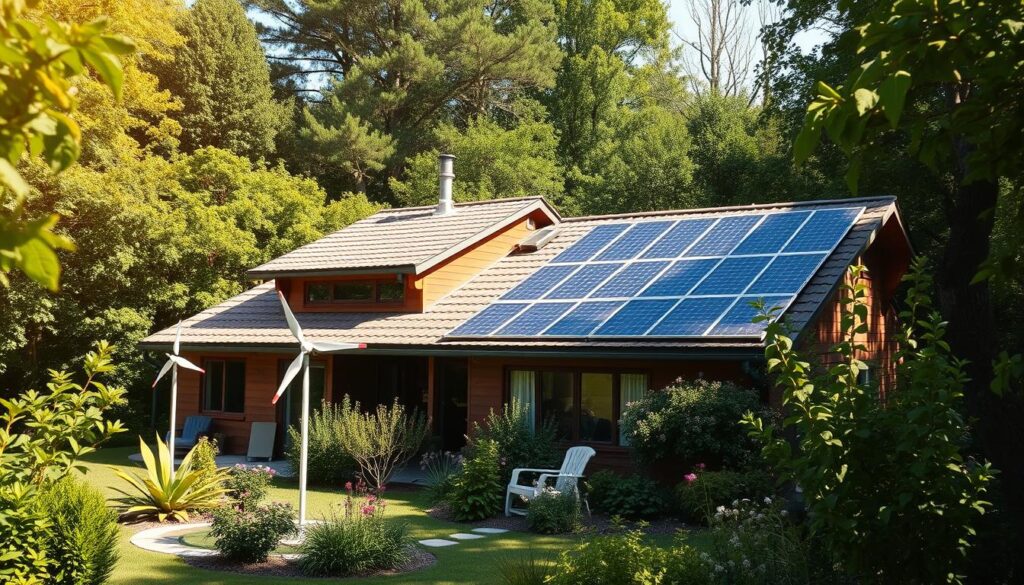
Sustainable Landscaping and Outdoor Spaces
Creating an eco-friendly home is not just about the inside. Sustainable landscaping and outdoor areas are key to reducing environmental impact. They also make your property more beautiful. Using native plants, water-saving xeriscaping, and permeable paving can create a stunning, green space.
Native plants are a cornerstone of sustainable landscaping. They need little care and water, saving resources. These plants also help local wildlife by providing food and shelter.
Xeriscaping focuses on saving water. It uses plants that don’t need much water and efficient irrigation systems. This cuts down your water use and makes your landscape easy to care for.
Permeable paving is another important part of outdoor design. It lets rainwater soak into the ground, helping to recharge water supplies. This reduces flooding and supports the natural water cycle.
Green roofs add to your home’s sustainability. They are covered in plants that help with insulation, reduce energy use, and clean the air. They also provide a home for urban wildlife.
| Sustainable Landscaping Technique | Benefits |
|---|---|
| Native Plants | Reduced maintenance, water requirements, and support for local ecosystems |
| Xeriscaping | Water conservation and low-maintenance landscaping |
| Permeable Paving | Groundwater recharge, reduced stormwater runoff, and flood mitigation |
| Green Roofs | Improved insulation, reduced energy demands, air filtration, and urban wildlife habitat |
By using these sustainable landscaping and outdoor design strategies, you can make a beautiful, eco-friendly space. This space will not only look great but also help the environment for a healthier future.
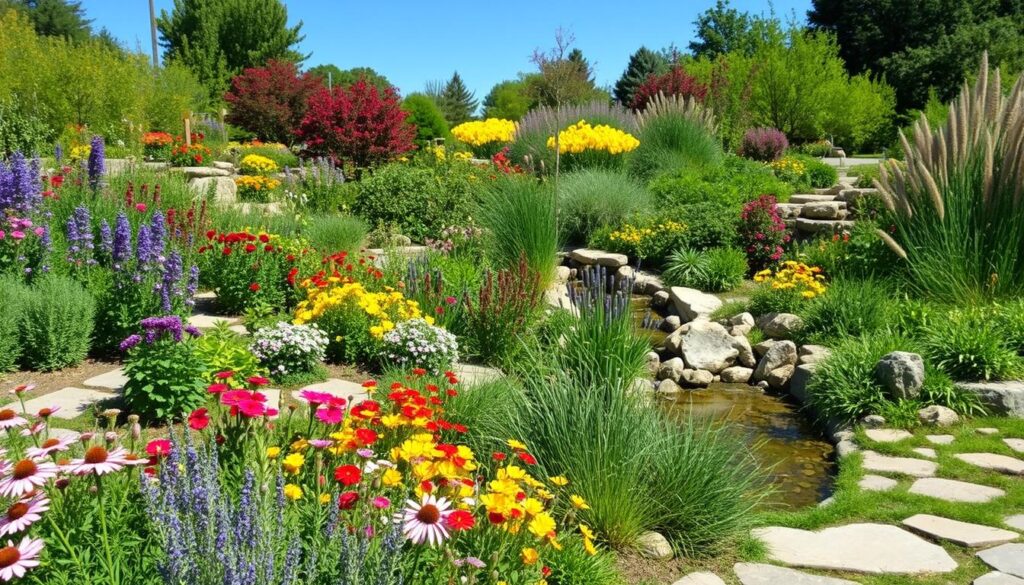
Waste Management and Recycling Systems
In today’s world, managing waste and recycling is key to a greener home. Homeowners can set up recycling centers and use composting solutions. These steps help reduce waste and support a circular economy.
Composting Solutions
Composting is a top waste reduction strategy. It turns kitchen scraps and yard waste into soil for gardens. This method cuts down on landfill waste and gives plants a natural fertilizer boost.
Zero-Waste Kitchen Design
A zero-waste kitchen design helps reduce waste. It involves choosing the right storage and using reusable items. By planning meals and using eco-friendly accessories, kitchens can be more sustainable.
Having a good waste management system is essential for a green home. It includes recycling centers, composting, and zero-waste kitchens. These efforts make a big difference for the environment and improve our homes.
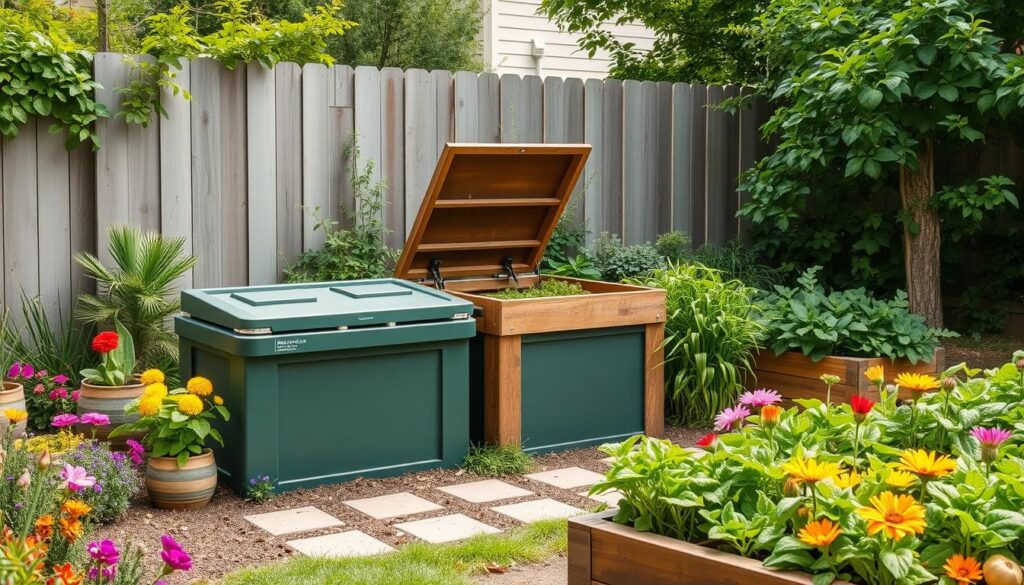
Energy-Efficient HVAC Systems
Building an eco-friendly home means thinking about every detail, including the HVAC system. Homeowners have many ways to cut down on energy use and save money.
Geothermal systems are a smart choice. They use underground temperatures for heating and cooling. This makes them a better choice than old HVAC systems, saving a lot of energy and money.
High-efficiency heat pumps are also great for saving energy. They heat and cool your home using less energy than traditional systems. Heat pumps move heat, not make it, which saves a lot of energy.
For energy-saving air conditioning, there are many options. High-SEER air conditioners and ductless mini-split systems are just a few. They help cut down energy use and lower bills without losing comfort.
| HVAC System | Energy Efficiency | Cost Savings | Environmental Impact |
|---|---|---|---|
| Geothermal System | Extremely High | Substantial | Minimal Carbon Footprint |
| High-Efficiency Heat Pump | Very High | Significant | Reduced Emissions |
| Energy-Saving Air Conditioning | High | Moderate | Lower Energy Consumption |
Choosing energy-efficient HVAC systems helps the planet and saves money over time. These new technologies make homes more sustainable and comfortable.
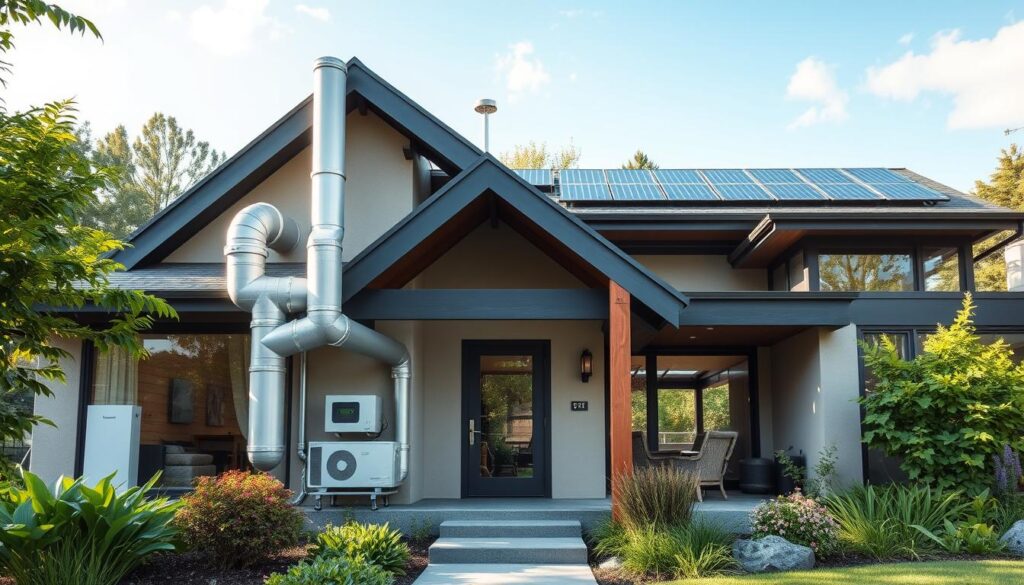
Green Home Certification Programs
More and more homeowners want to live sustainably. They look for green building certifications to prove their homes are eco-friendly. LEED for Homes and Energy Star certification are two top programs.
LEED Certification Process
The LEED (Leadership in Energy and Environmental Design) certification checks a home’s energy use, water saving, air quality, and sustainability. To get LEED for Homes, homes must meet strict rules in several areas. These include:
- Energy and atmosphere
- Indoor environmental quality
- Materials and resources
- Location and transportation
- Water efficiency
- Innovation
Getting LEED certification is a big step. It shows a home meets top green building standards.
Energy Star Requirements
The Energy Star program focuses on a home’s energy use. A home needs to meet certain standards for insulation, windows, and heating and cooling. Energy Star is less expensive and easier to get than LEED.
| Certification | Focus | Requirements | Benefits |
|---|---|---|---|
| LEED for Homes | Comprehensive sustainability | Stringent criteria across multiple categories | Highest standard of green building, increased home value |
| Energy Star | Energy efficiency | Specific energy-related features | Lower utility bills, environmental impact reduction |
Both green building certifications let homeowners show they care about the planet. They can pick the best program for their needs and budget.
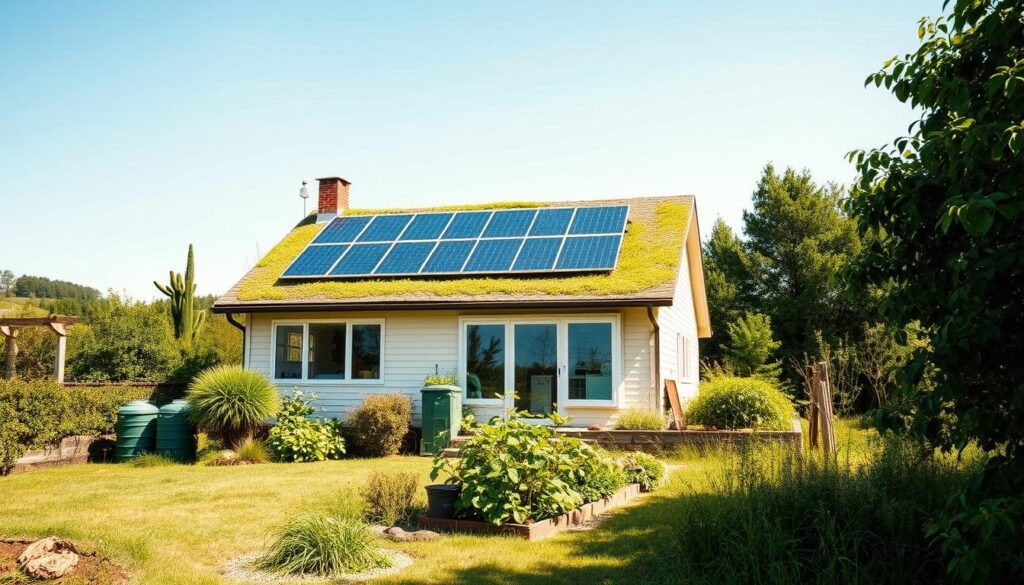
Maintenance Tips for Eco-Friendly Homes
Keeping an eco-friendly home in top shape needs a lot of effort. Homeowners should use green cleaning products and follow energy-efficient maintenance tips. This way, their homes stay both lovely and good for the planet.
Choosing the right eco-friendly cleaning solutions is crucial. Plant-based, biodegradable cleaners are better for the environment and keep homes healthy. Also, using energy-efficient maintenance helps cut down energy use and carbon emissions.
For eco-friendly repairs, pick sustainable materials like recycled or reclaimed wood. This choice helps the environment and makes homes last longer. By focusing on sustainable home care, homeowners can keep their homes in line with their green values.
| Sustainable Home Care Strategies | Benefits |
|---|---|
| Use of green cleaning products | Reduces environmental impact, improves indoor air quality |
| Energy-efficient maintenance practices | Lowers energy consumption, reduces carbon footprint |
| Eco-friendly repair solutions | Supports conservation of resources, enhances home durability |
By taking a full approach to sustainable home care, homeowners can have a beautiful, eco-friendly home. This home reflects their green values and helps make the future more sustainable.
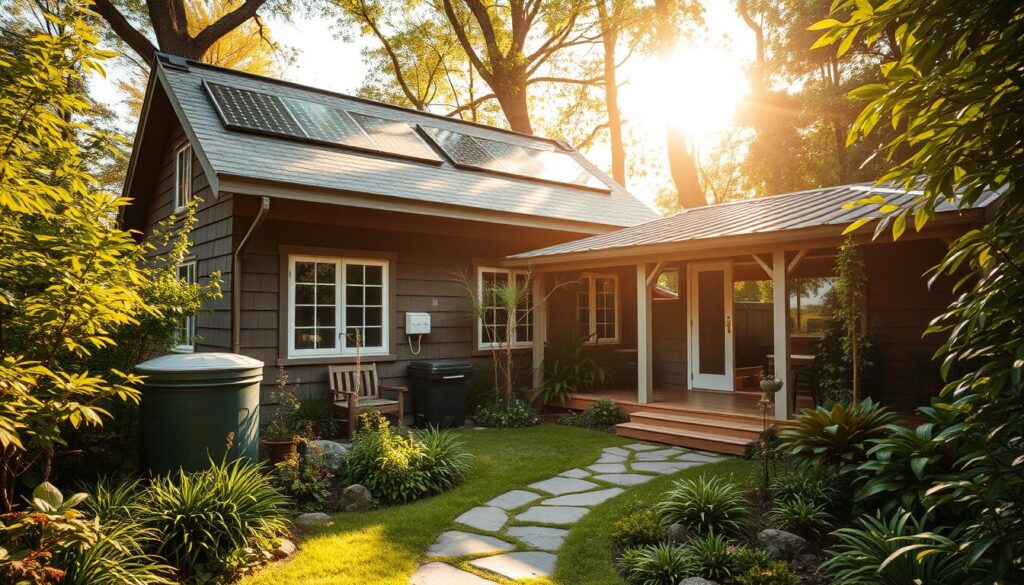
Cost-Effective Green Home Upgrades
Homeowners looking to make their homes eco-friendly can find many affordable options. These upgrades save energy and help the environment. They include energy-efficient windows, insulation, and smart home tech.
Budget-Friendly Modifications
Upgrading to Energy Star appliances and LED bulbs is a smart move. It cuts down on energy use and lowers bills. Adding insulation and fixing air leaks also helps a lot.
Small changes like using programmable thermostats and water-saving fixtures can make a big difference. They’re easy on the wallet but good for the planet.
Return on Investment Analysis
Thinking about the return on investment (ROI) is key. Solar panels or geothermal systems cost more upfront but save money in the long run. They also boost your home’s value.
On the other hand, cheaper fixes like new windows or smart devices pay off faster. By comparing costs and benefits, you can choose upgrades that fit your budget and values.
Conclusion
Creating a sustainable home is about combining eco-friendly practices with stylish design. By choosing green materials, energy-efficient systems, and sustainable landscaping, you can reduce your environmental impact without compromising on beauty or comfort. Small steps like improving insulation, using smart home technology, or adding natural lighting can make a big difference over time.
Whether you’re renovating an existing home or building from scratch, sustainable choices save money, conserve resources, and enhance your quality of life. Embracing these principles not only benefits the planet but also ensures a healthier and more efficient living space for years to come. Start your journey toward a greener, more beautiful home today!

